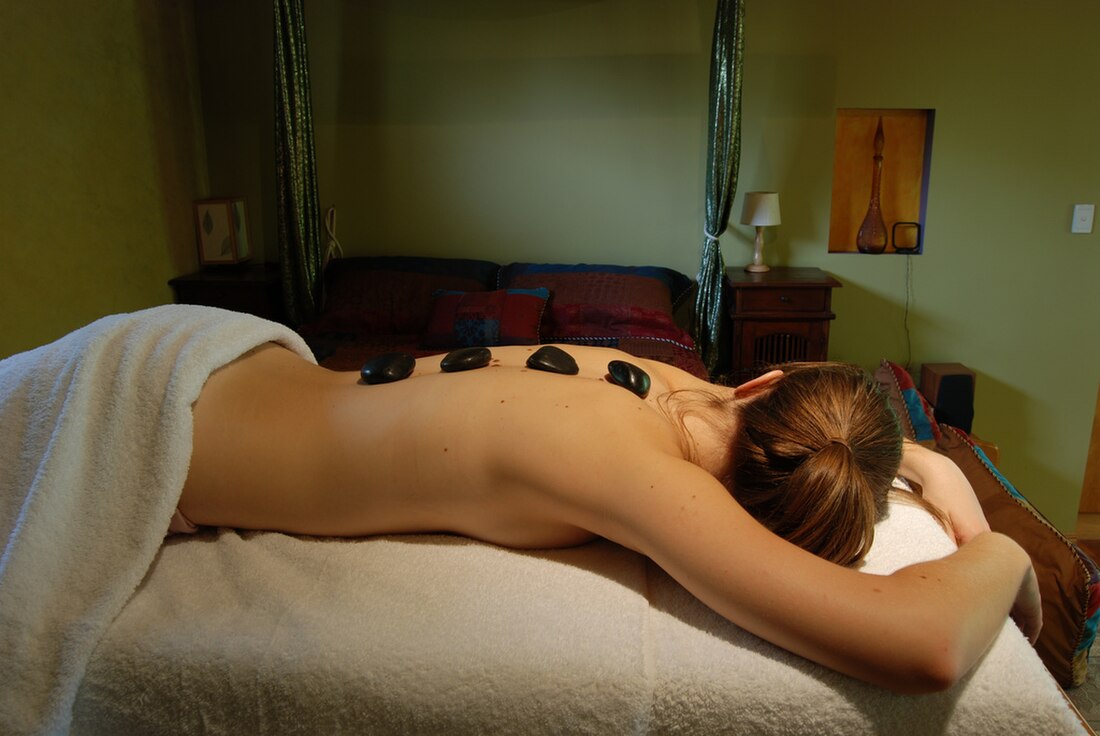Stone massage
Form of massage therapy From Wikipedia, the free encyclopedia
A stone massage is a form of alternative medicine massage that involves the placement of either heated or cooled stones on the body. This practice is used with the aim of providing relief and relaxation.[1] Different traditions have different placement and usage of the stones.[2] Stone massages are primarily applied in attempts to alleviate physical pain and promote relaxation and stress reduction.[1]
This article has multiple issues. Please help improve it or discuss these issues on the talk page. (Learn how and when to remove these messages)
|

Origin and history
Summarize
Perspective
Practices similar to modern stone massage, involving placing objects of various temperatures on the body, have been used in the past for healing and therapy.[1] Some sources suggest the practice originated 5,000 years ago within the ancient Indian medicinal system of Ayurveda.[1] Cultures in North America, Hawaii, Japan, and various South Pacific nations have employed similar methods for therapeutic or ceremonial purposes.[2] The traditional Hawaiian practice of Lomilomi massage may involve the use of warmed Lomi stones to increase blood flow to areas of the body, which proponents claim to support relaxation and the circulation.[3] Similar practices in China dating back 2,000 years involved the use of heated stones, said to stimulate internal organ function and improve energy flow.[2] Such traditional practices have influenced modern stone massage methods.
In 1993, modern stone massage techniques gained renewed attention when Mary D. Nelson, an American massage therapist, developed a form of massage using hot and cold stones, referred to as ‘LaStone Therapy’.[1] This form of massage became popular and commercially successful.[4] Numerous modern forms of stone massage incorporate techniques from Swedish massage and deep tissue massage.[5]
Technique

Volcanic stones, such as basalt, are typically submerged in hot water, usually between 38 and 60 degrees Celsius (100 to 140 degrees Fahrenheit). They should not be warmed using mediums other than water.[1] Stones can also be placed in chilled water to achieve a temperature between -5 to 25 degrees Celsius (25 to 75 degrees Fahrenheit). A sheet or towel is often placed on the client's body as a barrier between the stones and bare skin to help prevent discomfort from temperature changes or burns from excessively hot stones.[5] Stones may be placed on the client's back, legs, arms, or feet, depending on the treatment area. During the massage, the therapist may hold the stones and use them to apply pressure to muscles, effectively acting as an extension of their hands.[6]
Some therapists may also perform a Swedish massage while applying stones to warm and relax muscles.[7] The duration of stone massages typically ranges from 60 to 90 minutes, varying based on the technique used and client needs.[7] Stone massage is often combined with complementary therapies, such as aromatherapy, to enhance its effects.
Effectiveness
Summarize
Perspective
Benefits
Reported benefits of the practice include stimulation of blood flow in the circulatory system through the heat and movement of the stones.[1] Stone massages are also reported to ease muscle pain, tension, and spasms.[8]
Some proponents claim that stone massage may offer mental benefits such as relaxation, mood improvement, and an enhanced sense of well-being.[2] A study conducted at the Urmia University of Medical Sciences found that basalt hot stone massage therapy can contribute to improving the sleep quality of some individuals.[9]
Risks
There are potential dangers and risks associated with stone massage therapy. One risk is burns, which can result from placing high-temperature objects on the skin.[5]
Certain medical conditions can increase the risks involved in receiving a stone massage. Conditions such as diabetes, epilepsy, some skin conditions, heart disease, and neuropathy are considered contraindications for stone massage.[5] Clients with cuts, burns, bruising, or varicose veins are advised to avoid stone massages as the practice has the potential to increase injury or tissue damage.[8] Such conditions or minor injuries also pose a risk for increased chances of infection from exposure to bacterial from the stones, massage oils, or the masseuse.[8]
Being under the influence of drugs or alcohol significantly reduces the safety of stone massage therapy. Clients' reactions to the temperature of the stones may be desensitized by drugs or alcohol, increasing the risk of burns.[10]
Pseudoscience
Some massage therapists may make claims about medical benefits that are not scientifically supported. Some forms of stone massage incorporate concepts such as chakra alignment and energy flow,[11] but these concepts are not typically supported by science. While some individuals may find stone massages pleasant or relatively harmless, it is important to consult with a relevant medical professional for proper assessment, diagnosis, and treatment of any pain or medical concern.
See also
References
Wikiwand - on
Seamless Wikipedia browsing. On steroids.
